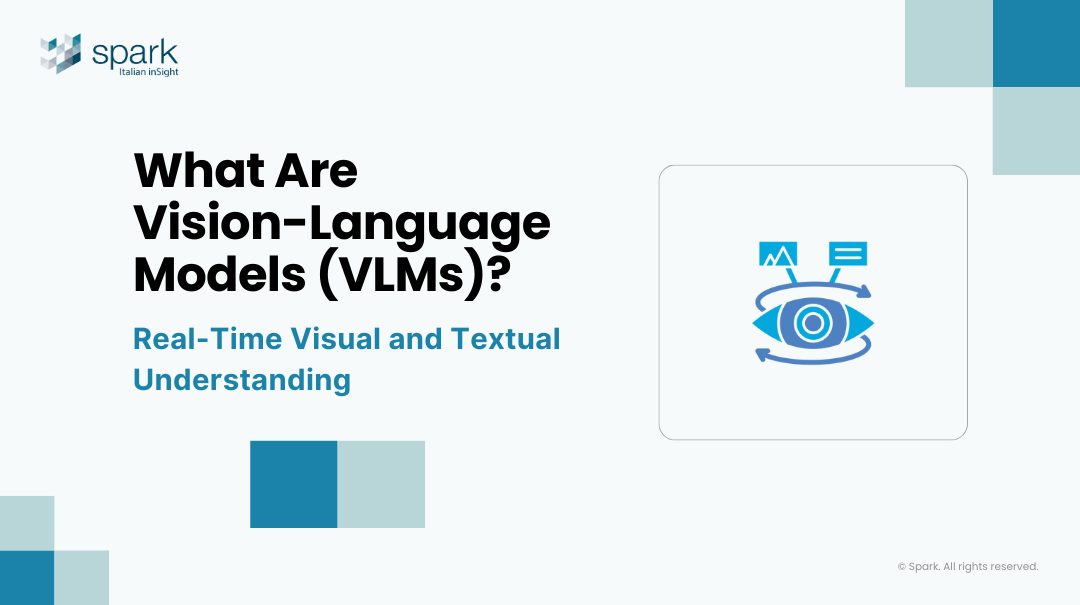2025.09.19
Why DO We Need VLM?
The evolution of artificial intelligence has gradually moved from text to speech, from images to multimodal processing, increasingly mirroring human understanding. Early Natural Language Processing (NLP) models could process text, and Computer Vision (CV) models could understand images, but each operated in isolation. Today, with the emergence of VLM (Vision-Language Model), AI can simultaneously "see" and "understand," entering the era of true cross-modal intelligence.
VLM is not just a technological iteration—it is a key driver for industries moving toward intelligent automation. By combining visual and textual information, it transforms data into knowledge and supports decision-making.

LLM vs VLM?
Before discussing VLM, another commonly mentioned term is LLM (Large Language Model). Despite their similar names, these two have significant differences in scope and capabilities:
Input and processing modalities:
-
LLM: Primarily handles text-based tasks such as conversation, translation, summarization, and code generation.
-
VLM: Processes both text and images, enabling reasoning that combines visual content with language.
Capability scope:
-
LLM: Excels in logic and knowledge within language but cannot "see" images.
-
VLM: Can "see" and "speak." For example, given a medical image and a question, the model can provide a textual answer.
Application scenarios:
-
LLM: Commonly used in customer service chatbots, knowledge Q&A, content generation, and coding assistants.
-
VLM: Applied in intelligent surveillance, medical image diagnosis, product search, educational content, and other scenarios that combine text and images.
Evolutionary relationship:
VLM can be considered a "multimodal extension" of LLM. It builds on the language capabilities of LLM while adding visual understanding, bringing AI closer to human multisensory perception.
In short:
-
LLM = "AI that understands language"
-
VLM = "AI that can see images and understand language"
What is VLM?
VLM, or Vision-Language Model, is an AI model capable of processing both images and text simultaneously. It is not simply an image recognizer or a text processor; it enables cross-modal understanding and reasoning.
Examples:
-
Given an image, it can generate a textual description, e.g., "This is a photo of children playing soccer on a playground."
-
It can answer questions related to an image, e.g., "How many people are in the photo?" or "Who is kicking the ball?"
-
It can even operate in reverse, generating images from textual prompts, e.g., "Draw a scene of a meeting in an office."
This cross-modal capability makes VLM an AI that closely mirrors human perception.
VLM vs Traditional Models
Before VLM, most AI models were single-modal:
-
NLP models (e.g., GPT, BERT): Good at text understanding and generation but cannot see images.
-
CV models (e.g., ResNet, YOLO): Can recognize objects in images but cannot explain them in language.
VLM combines the strengths of both:
-
Aligns images with language: Learns to map visual features to textual semantics.
-
Cross-modal reasoning: Utilizes both visual and textual information to answer questions or generate content.
Representative open-source models include CLIP (OpenAI), BLIP, and LLaVA, demonstrating the potential of cross-modal AI.
Core Capabilities of VLM
-
Image Captioning
-
Converts images into natural language descriptions.
-
Applications: digital asset management, social platforms, assistive technology for the visually impaired.
-
-
Visual Question Answering (VQA)
-
Answers questions about an image.
-
Applications: medical image diagnosis support, industrial inspection reports.
-
-
Cross-Modal Retrieval
-
Search by image or by text.
-
Applications: e-commerce product search, digital library management.
-
-
Cross-Modal Generation
-
Generate images from text (Text-to-Image) or text from images (Image-to-Text).
-
Applications: marketing material automation, design assistance.
-
-
Decision Support
-
Combines visual data and textual reports for professional analysis.
-
Medical: Combine patient imaging with medical records.
-
Security: Combine surveillance footage with event descriptions for automated anomaly reporting.
-
Application Areas of VLM
-
Intelligent Security:
Users can query, e.g., "Was anyone loitering at the main gate today?" The system quickly analyzes footage and responds, even generating automated reports. -
Education and Training:
VLM can combine instructional images with explanations. Students can ask, "What is the key point of this image?" and receive real-time textual explanations. -
Smart Retail:
Customers can input queries like "Find a pair of black sneakers," and the system matches product images to recommend the best results. -
Industrial Inspection:
VLM can detect defects on production lines and produce natural language reports, helping engineers understand problems faster. -
Medical Imaging:
Assists doctors in analyzing X-rays, MRIs, or CT scans and generates preliminary diagnostic reports, improving efficiency.
Challenge andFuture Directions
While VLM has enormous potential, real-world deployment faces challenges:
-
Large data requirements: Multimodal training requires datasets with both images and annotated text, which is costly and difficult to obtain.
-
Compute and cost constraints: Large model sizes require high computational resources for inference.
-
Domain knowledge limitations: General models are powerful but need domain-specific fine-tuning for areas like healthcare or industry.
Future directions:
-
Real-time processing: Edge AI technology can reduce latency, supporting instant interaction with images and language.
-
Industry-focused models: More customized VLMs for vertical applications.
-
Private deployment: Enterprises’ data privacy needs will drive the adoption of dedicated VLM solutions.

VLM is no longer just cutting-edge research—it is gradually entering practical applications. AI that can "see images and understand language" is becoming a key tool for improving efficiency, reducing labor, and creating value across industries.
We are actively investing in VLM research and will soon release solutions targeting [insert your target domain, e.g., smart transportation, smart retail, industrial inspection], helping enterprises transform visual and textual data into actionable insights.
Stay tuned for upcoming product announcements or contact us to explore the possibilities of VLM in your industry!
Why DO We Need VLM?
The evolution of artificial intelligence has gradually moved from text to speech, from images to multimodal processing, increasingly mirroring human understanding. Early Natural Language Processing (NLP) models could process text, and Computer Vision (CV) models could understand images, but each operated in isolation. Today, with the emergence of VLM (Vision-Language Model), AI can simultaneously "see" and "understand," entering the era of true cross-modal intelligence.
VLM is not just a technological iteration—it is a key driver for industries moving toward intelligent automation. By combining visual and textual information, it transforms data into knowledge and supports decision-making.

LLM vs VLM?
Before discussing VLM, another commonly mentioned term is LLM (Large Language Model). Despite their similar names, these two have significant differences in scope and capabilities:
Input and processing modalities:
-
LLM: Primarily handles text-based tasks such as conversation, translation, summarization, and code generation.
-
VLM: Processes both text and images, enabling reasoning that combines visual content with language.
Capability scope:
-
LLM: Excels in logic and knowledge within language but cannot "see" images.
-
VLM: Can "see" and "speak." For example, given a medical image and a question, the model can provide a textual answer.
Application scenarios:
-
LLM: Commonly used in customer service chatbots, knowledge Q&A, content generation, and coding assistants.
-
VLM: Applied in intelligent surveillance, medical image diagnosis, product search, educational content, and other scenarios that combine text and images.
Evolutionary relationship:
VLM can be considered a "multimodal extension" of LLM. It builds on the language capabilities of LLM while adding visual understanding, bringing AI closer to human multisensory perception.
In short:
-
LLM = "AI that understands language"
-
VLM = "AI that can see images and understand language"
What is VLM?
VLM, or Vision-Language Model, is an AI model capable of processing both images and text simultaneously. It is not simply an image recognizer or a text processor; it enables cross-modal understanding and reasoning.
Examples:
-
Given an image, it can generate a textual description, e.g., "This is a photo of children playing soccer on a playground."
-
It can answer questions related to an image, e.g., "How many people are in the photo?" or "Who is kicking the ball?"
-
It can even operate in reverse, generating images from textual prompts, e.g., "Draw a scene of a meeting in an office."
This cross-modal capability makes VLM an AI that closely mirrors human perception.
VLM vs Traditional Models
Before VLM, most AI models were single-modal:
-
NLP models (e.g., GPT, BERT): Good at text understanding and generation but cannot see images.
-
CV models (e.g., ResNet, YOLO): Can recognize objects in images but cannot explain them in language.
VLM combines the strengths of both:
-
Aligns images with language: Learns to map visual features to textual semantics.
-
Cross-modal reasoning: Utilizes both visual and textual information to answer questions or generate content.
Representative open-source models include CLIP (OpenAI), BLIP, and LLaVA, demonstrating the potential of cross-modal AI.
Core Capabilities of VLM
-
Image Captioning
-
Converts images into natural language descriptions.
-
Applications: digital asset management, social platforms, assistive technology for the visually impaired.
-
-
Visual Question Answering (VQA)
-
Answers questions about an image.
-
Applications: medical image diagnosis support, industrial inspection reports.
-
-
Cross-Modal Retrieval
-
Search by image or by text.
-
Applications: e-commerce product search, digital library management.
-
-
Cross-Modal Generation
-
Generate images from text (Text-to-Image) or text from images (Image-to-Text).
-
Applications: marketing material automation, design assistance.
-
-
Decision Support
-
Combines visual data and textual reports for professional analysis.
-
Medical: Combine patient imaging with medical records.
-
Security: Combine surveillance footage with event descriptions for automated anomaly reporting.
-
Application Areas of VLM
-
Intelligent Security:
Users can query, e.g., "Was anyone loitering at the main gate today?" The system quickly analyzes footage and responds, even generating automated reports. -
Education and Training:
VLM can combine instructional images with explanations. Students can ask, "What is the key point of this image?" and receive real-time textual explanations. -
Smart Retail:
Customers can input queries like "Find a pair of black sneakers," and the system matches product images to recommend the best results. -
Industrial Inspection:
VLM can detect defects on production lines and produce natural language reports, helping engineers understand problems faster. -
Medical Imaging:
Assists doctors in analyzing X-rays, MRIs, or CT scans and generates preliminary diagnostic reports, improving efficiency.
Challenge andFuture Directions
While VLM has enormous potential, real-world deployment faces challenges:
-
Large data requirements: Multimodal training requires datasets with both images and annotated text, which is costly and difficult to obtain.
-
Compute and cost constraints: Large model sizes require high computational resources for inference.
-
Domain knowledge limitations: General models are powerful but need domain-specific fine-tuning for areas like healthcare or industry.
Future directions:
-
Real-time processing: Edge AI technology can reduce latency, supporting instant interaction with images and language.
-
Industry-focused models: More customized VLMs for vertical applications.
-
Private deployment: Enterprises’ data privacy needs will drive the adoption of dedicated VLM solutions.

VLM is no longer just cutting-edge research—it is gradually entering practical applications. AI that can "see images and understand language" is becoming a key tool for improving efficiency, reducing labor, and creating value across industries.
We are actively investing in VLM research and will soon release solutions targeting [insert your target domain, e.g., smart transportation, smart retail, industrial inspection], helping enterprises transform visual and textual data into actionable insights.
Stay tuned for upcoming product announcements or contact us to explore the possibilities of VLM in your industry!


